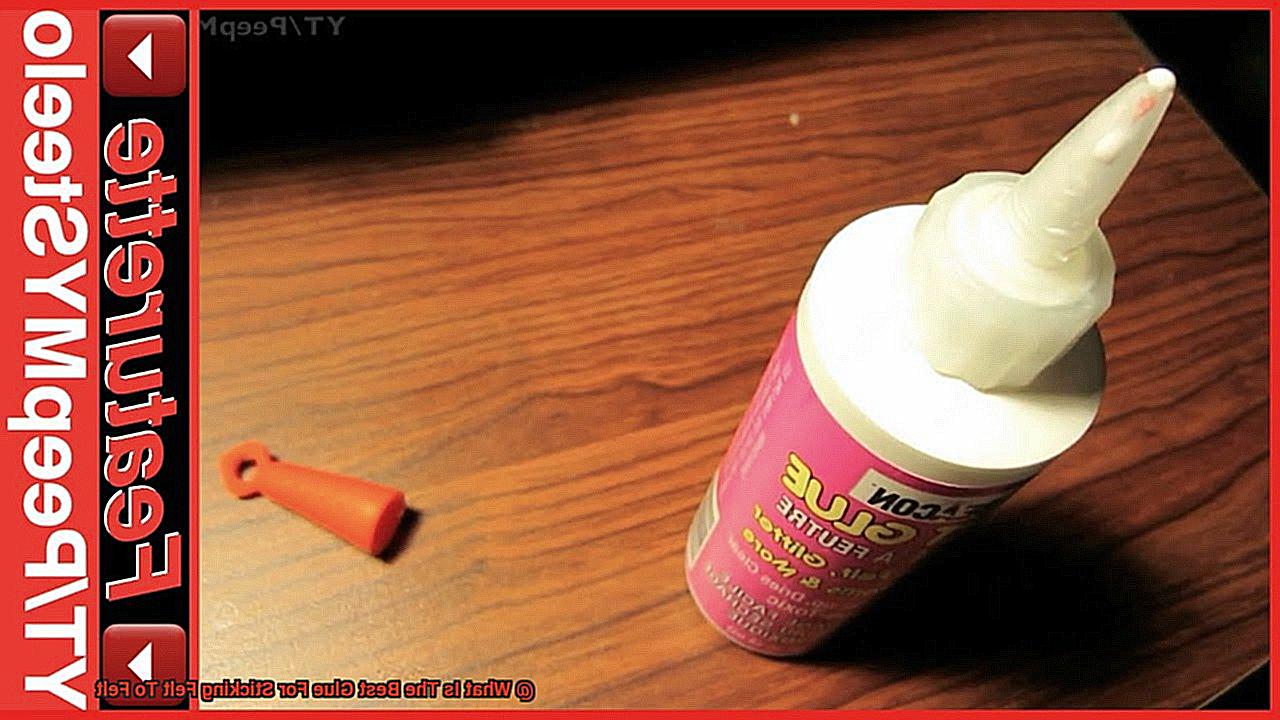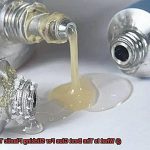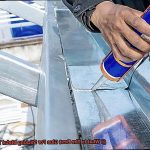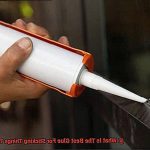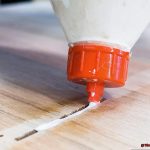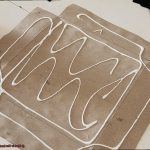Crafting with felt is a magical journey of creativity and imagination. Whether you’re sewing a plush toy, making a cozy blanket, or designing a funky piece of felt art, finding the right glue is like finding the perfect sidekick to your crafting adventures. It’s that trusty companion that ensures your felt creations stick together like best friends forever.
But let’s face it, with so many glues out there, it can be overwhelming to choose the one that will provide that strong and long-lasting bond we all crave. Fear not. In this blog post, we’ll embark on a quest to find the holy grail of adhesives for sticking felt to felt.
We’ll explore traditional glues that have been tried and tested by crafters throughout the ages. We’ll also dive into specialized craft adhesives specifically formulated for working wonders with our fuzzy friend, felt. By discussing their pros and cons, we’ll equip you with the knowledge to pick the perfect glue for your specific felt-related projects.
So gather your scissors, grab some colorful felts, and get ready to discover the adhesive superhero that will bring your felt creations to life. Let’s unveil the secrets of sticking felt to felt and make sure your crafts stay intact through all of life’s adventures.
Considerations When Choosing the Best Glue for Felt
Contents
Considerations When Choosing the Best Glue for Felt:
- Adhesive Type: Different types of adhesives, such as craft glue, fabric glue, hot glue, and spray adhesive, have different properties and suitability for felt. Consider the specific needs of your project and choose the adhesive type that best suits those requirements.
- Durability: Consider how durable the bond needs to be based on the intended use of your project. If the felt item will be handled frequently or washed, opt for a stronger adhesive that can withstand wear and tear.
- Drying Time: Take into account how quickly you need your project to be completed. Craft glues and fabric glues usually have shorter drying times, while hot glue dries quickly within seconds. Spray adhesives may require longer drying times.
- Application Method: Consider the ease of application when choosing a glue for felt. Craft glues and fabric glues typically come in squeeze bottles with narrow tips for precise application. Hot glue requires a glue gun, which may be trickier to handle for intricate or small projects. Spray adhesives are sprayed onto the felt.
- Safety: Ensure that the glue you choose is safe to use, especially if working with children. Look for non-toxic options and work in a well-ventilated area.
- Compatibility with Felt: Not all adhesives work well with felt, so make sure the glue you choose is compatible with this material. Craft glues and fabric glues are specifically designed for bonding fabrics, including felt, and are generally safe choices.
Fabric Glue
Fabric glue is a versatile adhesive specially designed for bonding fabric materials, making it an ideal choice for sticking felt to felt. Its ease of use sets it apart from other adhesives, as it does not require heat or sewing to create a strong bond. This convenience makes fabric glue accessible to both experienced crafters and beginners alike.
One of the key advantages of fabric glue is its flexibility. Felt is known for its pliability, and fabric glue allows this flexibility to be maintained even after drying. The adhesive will not crack or break, allowing your finished project to move and bend without any worry.
Choosing the right fabric glue is crucial for a successful bond. It is important to select a product specifically labeled for fabric use, as not all glues are suitable for fabric materials. Clear-drying and washable fabric glues are recommended for their versatility and user-friendliness.
Two highly recommended brands of fabric glue are Aleene’s Original Fabric Glue and Beacon Fabri-Tac. Aleene’s offers a strong bond and versatility, while Beacon Fabri-Tac boasts quick-drying time and long-lasting hold.
To ensure a successful bond between pieces of felt, it is essential to clean the surfaces before applying the glue. Removing dirt and oils will strengthen the adhesive’s bond. Applying the glue evenly in thin layers will also contribute to a stronger bond. Additionally, allowing the glue to fully dry before handling the project ensures a secure bond.
Craft Glue
Craft glue is an essential tool for any creative project. It is a versatile adhesive that can be used to bond various materials, including fabric, paper, wood, and more. Craft glue comes in different forms and formulas, each with its own advantages and disadvantages.
One common type of craft glue is white craft glue, also known as school glue or PVA glue. White craft glue is water-based and dries clear. It is easy to use and provides a strong bond for most craft projects. However, it may not be suitable for all materials and may not dry as quickly as other types of glue.
Another popular type of craft glue is clear-drying craft glue, which also dries transparent. Clear-drying glue is ideal for projects where you don’t want the glue to be visible after it dries. It is often used in paper crafts or when working with transparent materials.
For more heavy-duty projects or for bonding materials such as metal or plastic, epoxy glue or super glue may be more suitable. Epoxy glue is a two-part adhesive that provides an incredibly strong bond and is resistant to water and heat. Super glue, also known as cyanoacrylate adhesive, bonds quickly and strongly to most surfaces.
There are also specialty craft glues available that are designed for specific materials or purposes. For example, there are fabric glues that are specifically formulated to bond fabric together and provide a flexible hold. There are also wood glues that are designed to bond wood pieces securely.
When using craft glue, it’s important to follow the instructions provided by the manufacturer for the best results. Some general tips for using craft glue include:
- Make sure the surfaces you are bonding are clean and free from dust or debris.
- Apply the glue evenly and in a thin layer for optimal adhesion.
- Press the surfaces together firmly to ensure a strong bond.
- Allow the glue to dry completely before handling or moving the project.
Epoxy Adhesive
Epoxy adhesive is a superhero when it comes to sticking felt to felt. This powerful adhesive is the go-to choice for crafters, upholsterers, and DIY enthusiasts who want a bond that can withstand the test of time.
The secret behind epoxy adhesive’s strength lies in its two-component formula. It consists of a resin and a hardener that need to be mixed together before application. Once these components combine forces, the adhesive starts to harden, creating a bond that is as tough as nails.
One of the key benefits of using epoxy adhesive for sticking felt to felt is its ability to provide a permanent bond. Unlike other glues that may loosen over time or with exposure to moisture, epoxy adhesive creates a long-lasting connection that can brave any condition. This is particularly crucial when working with felt, a material often used in projects that demand durability, such as upholstery or crafts.
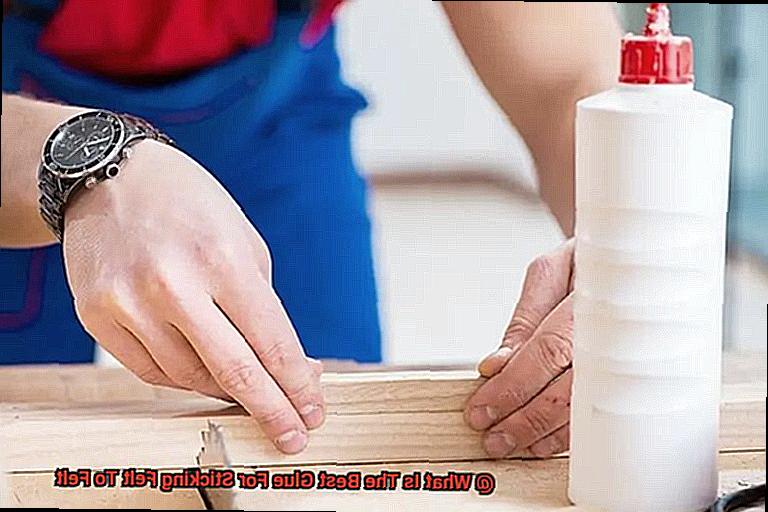
But that’s not all – epoxy adhesive has another trick up its sleeve. It has the remarkable ability to fill gaps and provide structural support. Felt can sometimes have uneven surfaces or spaces between layers, but fear not. Epoxy adhesive can step in and fill those gaps, ensuring a solid bond. This superpower comes in handy for projects where extra strength and stability are non-negotiable.
However, it’s important to follow the manufacturer’s instructions when using epoxy adhesive for sticking felt to felt. The resin and hardener must be mixed in the right ratio and applied evenly onto the surfaces being bonded. Patience is also key – giving the adhesive sufficient curing time to fully set is essential before handling or putting any stress on the bonded area.
It’s worth mentioning that not all types of felt may be compatible with epoxy adhesive. Some felts may have coatings or treatments that could affect the adhesive’s performance. To avoid any mishaps, it’s always wise to conduct a small test on an inconspicuous area before committing to the entire project.
Hot Glue Guns
Hot glue guns are versatile tools that are commonly used for bonding materials together, including felt. These guns operate by heating a solid glue stick until it melts and becomes a liquid adhesive that can be applied to surfaces. When working with felt, it is crucial to select the appropriate temperature setting on the hot glue gun. Most hot glue guns have adjustable temperature settings, allowing you to choose the right heat level for the type of felt you are using.
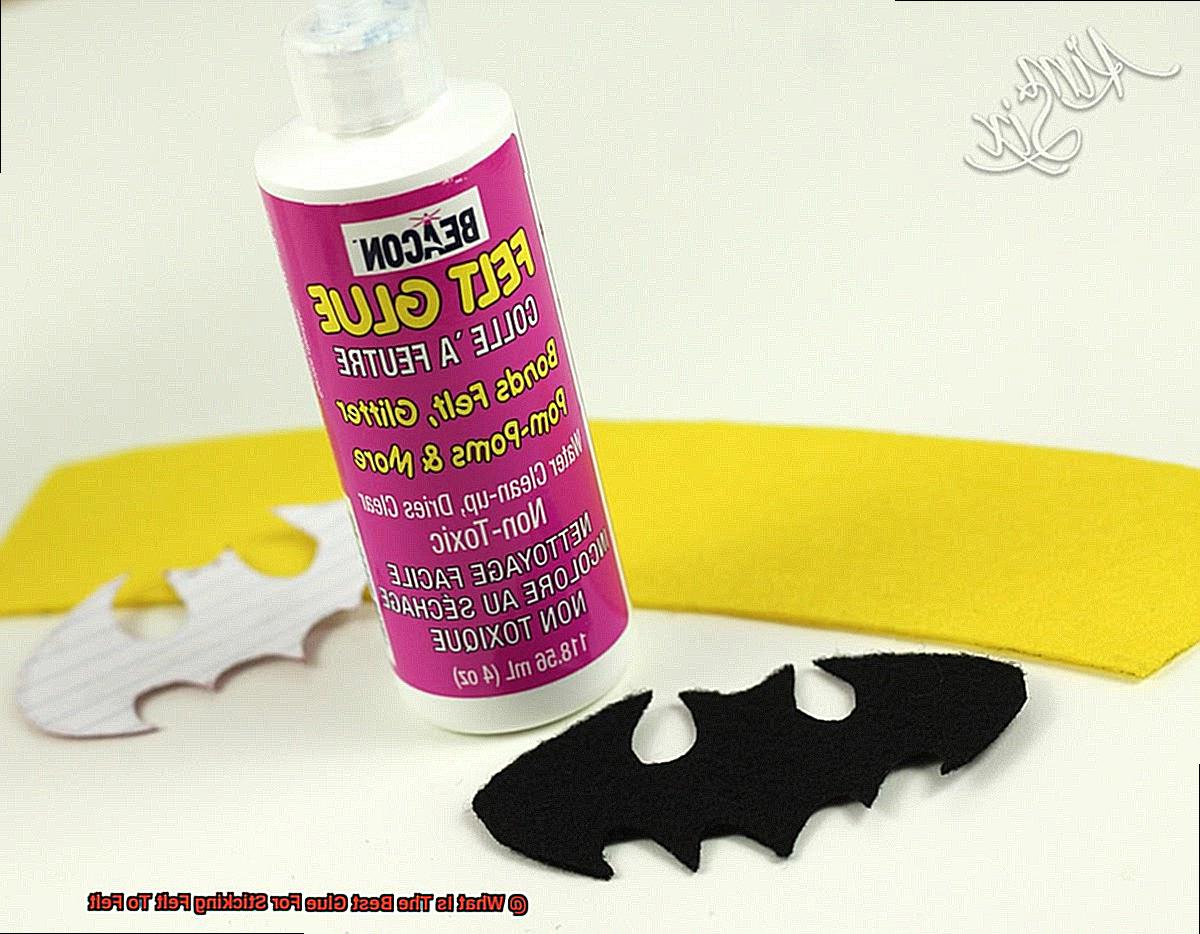
Lower temperature settings are generally recommended for delicate or thin felts, while higher temperatures are suitable for thicker or denser felts. It is essential to apply the hot glue in thin, even lines or dots to ensure proper adhesion without causing the felt to warp or become too stiff. Hot glue bonds quickly and securely, making it an ideal choice when working with felt that requires immediate adhesion.
There are several advantages to using hot glue guns for bonding felt. Firstly, hot glue provides a strong bond between felt pieces, ensuring that your project stays intact. Secondly, hot glue has a quick drying time, unlike other adhesives that require hours to dry. This allows you to continue working without any delay. Additionally, most hot glue guns have adjustable temperature settings, providing flexibility and convenience.
However, there are also some drawbacks to consider when using hot glue guns. Firstly, caution must be exercised when handling them as the melted adhesive can be extremely hot and may cause burns if not handled carefully. Secondly, hot glue may not be suitable for all types of felt projects. For example, if your project requires flexibility or frequent washing, other types of adhesives might be more appropriate.
Other Adhesives to Consider
When it comes to sticking felt to felt, there are a multitude of adhesives that can be considered beyond the commonly used fabric glue. These alternative options offer different benefits and may be more suitable for specific projects or personal preferences.
One option that stands out is hot glue, known for its powerful bond and rapid drying time. Crafters everywhere love hot glue guns for their availability and ease of use. However, it’s important to keep in mind that hot glue can get messy and may not be the best choice for delicate or thin felts.
Another adhesive option worth considering is spray adhesive. This handy product provides an even and smooth application, making it incredibly convenient. Spray adhesives also allow for repositioning of the felt before it fully sets, giving you some flexibility during the adhering process. Just ensure that you choose a spray adhesive specifically designed for fabric or felt to guarantee a secure bond.
If precision is what you’re after, double-sided adhesive tape is your go-to option. This tape offers a clean and precise application without any mess. It’s particularly useful for small or intricate projects where accuracy is paramount. You can easily cut the tape into different shapes or strips to fit your needs, providing a quick and convenient bonding solution. However, it’s important to note that double-sided adhesive tape may not offer the same level of durability as other adhesives, especially if your felt creation will be subject to heavy use or washing.
Liquid fabric glues deserve a mention as well. These glues are specially formulated for bonding fabrics, including felt. They typically provide a strong bond and are washable after drying, making them ideal for projects that require frequent washing or exposure to moisture. To ensure a secure bond, be sure to follow the manufacturer’s instructions regarding proper application and drying time.
For those seeking maximum strength and durability, epoxy adhesives or super glues are worth considering. These adhesives are known for their high strength and ability to withstand heavy use or stress. However, they can be a bit tricky to work with due to their fast-drying nature, requiring careful application. It’s important to exercise caution when using epoxy adhesives or super glues as they can cause skin irritation and emit strong fumes. Ventilation and safety measures should always be considered when working with these adhesives.
Tips for Applying Glue to Felt
- Choose the right glue: When it comes to sticking felt to felt, it is important to choose the right type of glue. There are several options available, including fabric glue, craft glue, and even hot glue. Fabric glue is generally a good choice as it is specifically designed for bonding fabric materials like felt. It provides a strong and durable bond without damaging the fabric.
- Test the glue: Before applying the glue directly onto your felt project, it is always a good idea to conduct a small test on a scrap piece of felt. This will help you determine whether the glue is suitable for your specific project and whether it causes any discoloration or damage to the fabric. Apply a small amount of glue on the scrap piece and let it dry completely. Check if the bond is strong and if the fabric retains its original color and texture.
- Clean the surface: Before applying any glue, make sure that the surface of your felt is clean and free from dust, dirt, or any other debris. This will ensure better adhesion and a stronger bond. Use a lint roller or a soft brush to gently remove any loose particles from the felt.
- Apply glue sparingly: When applying glue to felt, less is often more. Apply a thin layer of glue on one surface of the felt, either using a small brush or by squeezing it directly from the bottle. Avoid applying too much glue as it may seep through the fabric and leave visible marks or cause the felt to become stiff.
- Press firmly: Once you have applied the glue, press the two pieces of felt together firmly. This will help create a strong bond between the two surfaces. You can use your fingers or a flat object like a ruler or a book to evenly distribute the pressure across the glued area.
-
Allow proper drying time: Different glues have different drying times, so make sure to follow the manufacturer’s instructions. Avoid moving or manipulating the glued felt until it is completely dry to prevent any accidental shifting or weakening of the bond. It is recommended to allow the glued project to dry overnight for maximum strength.
- Consider additional reinforcement: Depending on the nature of your felt project, you may want to consider additional reinforcement methods to ensure a long-lasting bond. For example, stitching along the edges of the glued pieces can provide extra strength and durability.
-TLVBGkYVt0″ >
Conclusion
In conclusion, there are numerous adhesive options available for sticking felt to felt, each with its own unique advantages and considerations. Fabric glue emerges as a versatile choice that offers both flexibility and ease of use. Specifically formulated for bonding fabric materials like felt, it provides a robust and long-lasting bond that can be relied upon. Renowned brands such as Aleene’s Original Fabric Glue and Beacon Fabri-Tac come highly recommended for their unwavering reliability.
Craft glue presents another viable option that works well with various materials, including felt. With white craft glue and clear-drying craft glue leading the way in crafting projects, their versatility and strength make them a popular choice. However, it is important to note that not all types of felt projects may be compatible with these glues.
For those seeking an adhesive with unmatched power and structural support, epoxy adhesive takes center stage. Delivering a permanent bond that ensures durability and stability, it demands careful application and curing time to achieve optimal results.
Hot glue guns offer the advantage of quick drying time coupled with a formidable bond, making them ideal for situations requiring immediate adhesion. However, caution must be exercised when handling these guns due to the potential risk of burns.
Additional adhesive options worth considering include spray adhesive, double-sided adhesive tape, liquid fabric glues, epoxy adhesives, and super glues. Each option boasts its own set of benefits depending on the specific requirements of your project.
When applying glue to felt, several crucial steps should be followed to ensure success: choose the appropriate type of glue; conduct a small test on scrap fabric beforehand; meticulously clean the surface; apply the glue sparingly but evenly; exert firm pressure during bonding; allow ample drying time before handling the project; and consider implementing additional reinforcement if necessary.
By taking these factors into account and selecting the most suitable adhesive for your individual project needs, you can rest assured that your felt creations will remain securely bonded for years of enjoyment.

